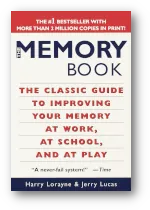Here’s a study technique to help you memorize more effectively. I’ll show you how to learn through association and prove that using your imagination to memorize can be both efficient and fun.
Associative memorization is all about creating wild mental images that include the information you want to remember. Later, by reconstructing these images, you’ll be able to retrieve that information easily.
Sounds confusing? Keep reading—I’ll break it down with some examples!
Studying by Memorization
For some students, memorizing is the absolute worst. The traditional way? Repeating a text over and over until you can’t take it anymore. Have you ever done that?
Luckily, human memory doesn’t just work that way. Your brain is wired to make all kinds of connections, and there are ways to train it to help you study more effectively.
Let me show you how!
Memorization in Everyday Life
Let’s start with an example.
Imagine you’re walking down the street, and as you cross, you notice something completely bizarre—a baby is behind the wheel of a car, waiting at the traffic light. Yep, a baby with a pacifier When you look at them, they smile at you and drool a little. Then, the light turns green, and off they go, disappearing into traffic.
Now, fast-forward to the end of the day. As you’re lying in bed, you can’t stop thinking about it. Weeks later, when you’re hanging out with friends, you’ll still tell the story, down to the smallest details—how you saw a baby driving a car. Even years from now, you might randomly remember this wild scene.
Why does this happen?
Because your brain is wired to remember unusual, extraordinary events.
What about ordinary, everyday things? Not so much.
Do you remember exactly what you had for dinner three months ago? Of course not (unless you have an eidetic memory). That’s because eating dinner is just another mundane part of life—at least for those of us lucky enough to have food every day.
So, how does this help you memorize things for studying?
The answer: by creating mental images that are weird, ridiculous, or completely absurd—and associating them with what you need to remember.
This is called associative memory. But let me make it even clearer with a practical example!
Memorizing Through Association
Let’s say you need to memorize the following sequence of numbers: 12, 23, 20, 32.
Instead of trying to memorize these numbers directly, you can associate them with basketball players who wore those jersey numbers: John Stockton, Michael Jordan, Manu Ginobili, and Magic Johnson. To remember them better, you can imagine them playing together in a two-on-two game.
Let’s consider another example.
Here are three benefits of recycling:
- Saves energy
- Reduces collection costs
- Generates income from recyclable materials
Imagine Superman saving another superhero named Energy, then collecting all the garbage in the city at super speed and selling everything to Lex Luthor.
That’s a movie scene I’ve never seen before! I created it once, and now it will remain in my mind for a long time.
Of course, you need to know how to connect individual words with sentences, but this way it’s difficult to forget any of the items.
Memory works in a somewhat curious way. In this case, it is aided by imagination.
Think about all the images you can generate in your mind to better retain the information you need to study. Put this method into practice and verify its effectiveness.
Practice Memorizing Through Association Techniques
Now that you know this technique, try applying it gradually at different times. Don’t overuse it or try to memorize everything this way.
The ideal approach is to complement it with other study techniques so you can retain information more easily.
Combine association memorization with the use of mnemonic rules, among other methods, such as chunking.

The Memory Book: The Classic Guide to Improving Your Memory at Work, at School, and at Play
Harry Lorayne & Jerry Lucas
Through Harry Lorayne and Jerry Lucas’s simple, fail-safe memory system, you can become more effective, more imaginative, and more powerful at work, at school, in sports, and at play.
Find more content on Mentes Liberadas
That’s all for this article. I hope you enjoyed it.
You can make a donation to Mentes Liberadas through our Ko-Fi account. This way, you’ll be supporting the site, helping us create more content, resources, and online tools.
Thank you for taking the time to read.
See you in the next article on Mentes Liberadas.




